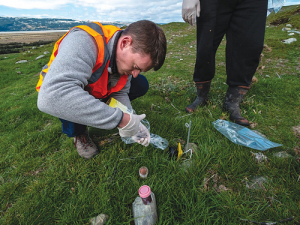NZ kiwifruit sector on alert for mysterious Italian disease
New Zealand's kiwifruit industry is on alert following reports of a mystery disease that is sweeping through Italian orchards.
 Manaaki Whenua intern Florian Chazottier collects flies from a trap set near an RHDV1 K5 virus release site at Glentanner. Photo: Manaaki Whenua / Bradley White.
Manaaki Whenua intern Florian Chazottier collects flies from a trap set near an RHDV1 K5 virus release site at Glentanner. Photo: Manaaki Whenua / Bradley White.
Scientists say although the new rabbit calicivirus is working as expected, farmers are not seeing the knockdown they may have hoped for.
The new strain of rabbit haemorrhagic virus disease, RHDV1-K5, was released several weeks ago at 150 sites.
Manaaki Whenua (Landcare Research) has monitored release sites since then.
“The first thing we wanted to know was whether the virus was killing rabbits within 5km of our release sites and that seems to be the case. So far we’ve detected the RHDV1-K5 in carcases at all the research sites,” lead researcher Dr Janine Duckworth told Rural News.
However, Otago Federated Farmers president Simon Davies says farmers are generally disappointed with the new virus.
“Certainly the feedback from farmers is that they’re disappointed with the result. They were probably expecting more like a 50-60% knock-down and the feedback we’re getting is it’s nothing like that... nothing like that at all.”
Davies says his own coastal farm has very few rabbits. But his “personal speculation” is that the virus was released a bit too late in the season when the vectors -- fleas -- were less active.
“I think they would like it reasonably warm otherwise they’re not going to be moving from host to host.”
Davies’ neighbour Allan Gunn, whose property is one of the release sites, agrees that the disease appears slow to act. But a particular pair of rabbits he had often seen on his property finally disappeared some weeks after the release.
Gunn says he was dubious at first, but the rabbits have since faded away, although “it wasn’t as quick as the last virus acted”.
The new variant is a Korean strain of the one illegally released in 1997; that was described as a Czech variant after it was first identified there.
Duckworth says they expected zero to 40% knockdown from the new virus, depending on how many susceptible rabbits were in the area. But there are places where the Czech virus will have recently gone through, giving some immunity.
“One of the major differences with this virus release is the rabbits have already seen RHDV type viruses and have built up some antibodies against them, so it’s not going to see the huge 80-90% die-off we saw in 1997; but it will be more effective over time.
“When you use a biocide it only affects the rabbits that eat the virus and then they die within one to two weeks. With a natural spread, the infection builds much more gradually but we see a longer period of infection. It will be six to eight weeks that the virus will still be slowly spreading through a rabbit population and we want to see this virus establish and be here long term as a new biocontrol agent,” Duckworth says.
Meanwhile, early data from the monitoring appeared to confirm the Australian experience, that flies are an important vector for the disease.
“What we’re not sure about in New Zealand is how far our flies move and how quickly the virus will spread here because we have a different fly population to that in Australia,” Duckworth says.
“RHD1K5 has been found in flies around the release sites and some distance away from those sites. So it looks as though the situation is similar to Australia and flies are an important vector for moving the virus longer distances.”
She says RHDV spreads either by rabbit to rabbit contact, contact of rabbits with faeces from an infected rabbit or from bedding material.
“But it also spreads across the land much faster than it could by rabbit-to-rabbit contact.”
Duckworth says monitoring and research are continuing. Spotlight night counts of rabbit populations are underway and will last for a few weeks.
The National Wild Goat Hunting Competition has removed 33,418 wild goats over the past three years.
New Zealand needs a new healthcare model to address rising rates of obesity in rural communities, with the current system leaving many patients unable to access effective treatment or long-term support, warn GPs.
Southland farmers are being urged to put safety first, following a spike in tip offs about risky handling of wind-damaged trees
Third-generation Ashburton dairy farmers TJ and Mark Stewart are no strangers to adapting and evolving.
When American retail giant Cosco came to audit Open Country Dairy’s new butter plant at the Waharoa site and give the green light to supply their American stores, they allowed themselves a week for the exercise.
Fonterra chair Peter McBride says the divestment of Mainland Group is their last significant asset sale and signals the end of structural changes.

OPINION: Your old mate welcomes the proposed changes to local government but notes it drew responses that ranged from the reasonable…
OPINION: A press release from the oxygen thieves running the hot air symposium on climate change, known as COP30, grabbed your…